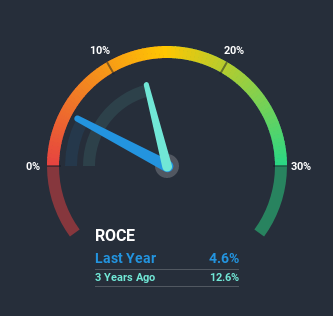
There are a few key trends to look for if we want to identify the next multi-bagger. Firstly, we'll want to see a proven return on capital employed (ROCE) that is increasing, and secondly, an expanding base of capital employed. If you see this, it typically means it's a company with a great business model and plenty of profitable reinvestment opportunities. Although, when we looked at Balmer Lawrie (NSE:BALMLAWRIE), it didn't seem to tick all of these boxes.
Return On Capital Employed (ROCE): What is it?
If you haven't worked with ROCE before, it measures the 'return' (pre-tax profit) a company generates from capital employed in its business. To calculate this metric for Balmer Lawrie, this is the formula:
Return on Capital Employed = Earnings Before Interest and Tax (EBIT) ÷ (Total Assets - Current Liabilities)
0.046 = ₹806m ÷ (₹23b - ₹5.2b) (Based on the trailing twelve months to September 2020).
Therefore, Balmer Lawrie has an ROCE of 4.6%. Ultimately, that's a low return and it under-performs the Industrials industry average of 10%.
See our latest analysis for Balmer Lawrie

Historical performance is a great place to start when researching a stock so above you can see the gauge for Balmer Lawrie's ROCE against it's prior returns. If you'd like to look at how Balmer Lawrie has performed in the past in other metrics, you can view this free graph of past earnings, revenue and cash flow.
What Can We Tell From Balmer Lawrie's ROCE Trend?
On the surface, the trend of ROCE at Balmer Lawrie doesn't inspire confidence. Around five years ago the returns on capital were 14%, but since then they've fallen to 4.6%. Given the business is employing more capital while revenue has slipped, this is a bit concerning. If this were to continue, you might be looking at a company that is trying to reinvest for growth but is actually losing market share since sales haven't increased.
In Conclusion...
We're a bit apprehensive about Balmer Lawrie because despite more capital being deployed in the business, returns on that capital and sales have both fallen. However the stock has delivered a 65% return to shareholders over the last five years, so investors might be expecting the trends to turn around. Regardless, we don't feel too comfortable with the fundamentals so we'd be steering clear of this stock for now.
If you'd like to know more about Balmer Lawrie, we've spotted 2 warning signs, and 1 of them is a bit concerning.
For those who like to invest in solid companies, check out this free list of companies with solid balance sheets and high returns on equity.
If you’re looking to trade Balmer Lawrie, open an account with the lowest-cost* platform trusted by professionals, Interactive Brokers. Their clients from over 200 countries and territories trade stocks, options, futures, forex, bonds and funds worldwide from a single integrated account. Promoted
Valuation is complex, but we're here to simplify it.
Discover if Balmer Lawrie might be undervalued or overvalued with our detailed analysis, featuring fair value estimates, potential risks, dividends, insider trades, and its financial condition.
Access Free AnalysisThis article by Simply Wall St is general in nature. It does not constitute a recommendation to buy or sell any stock, and does not take account of your objectives, or your financial situation. We aim to bring you long-term focused analysis driven by fundamental data. Note that our analysis may not factor in the latest price-sensitive company announcements or qualitative material. Simply Wall St has no position in any stocks mentioned.
*Interactive Brokers Rated Lowest Cost Broker by StockBrokers.com Annual Online Review 2020
Have feedback on this article? Concerned about the content? Get in touch with us directly. Alternatively, email editorial-team (at) simplywallst.com.
About NSEI:BALMLAWRIE
Balmer Lawrie
Engages in industrial packaging, greases and lubricants, chemicals, logistic services and infrastructure, refinery and oil field, and travel and vacation services businesses in India and internationally.
Flawless balance sheet with proven track record and pays a dividend.
Similar Companies
Market Insights
Community Narratives




